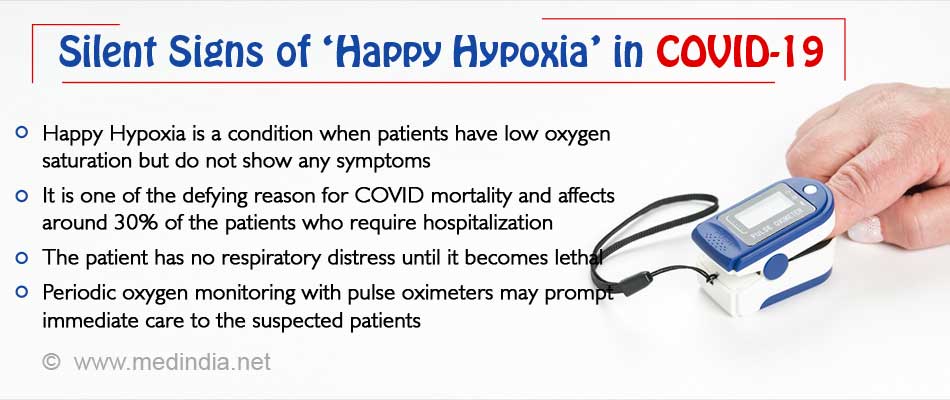, making the patients appear on the outside, to be alright and “happy”.
. However unnoticed symptoms like lips or skin discoloration to red or purple,
“In some instances, the patient is comfortable and using a phone at a point when the physician is about to insert a breathing [endotracheal] tube and connect the patient to a mechanical ventilator, which, while potentially lifesaving, carries its own set of risks,” says Rd. Martin J. Tobin, a professor of pulmonary and critical care medicine at the Loyola University Medical Center, in Maywood, IL.
Generally, the homeostatic mechanism of the body hints at least some sensory information to communicate to the brainstem for eliciting a compensatory reflex respiratory response. This effect lowers the CO2 level.
However, patients with happy hypoxia have no deliberate awareness of low oxygen/ hypoxia. The unclear mechanism behind this complication puzzles even the clinicians to cope with the management of coronavirus pneumonia.
Mechanism: Why is Happy Hypoxia Dangerous?
The primary cause of happy hypoxia is known to be widespread clotting in the complex network of small blood vessels in the lungs.
It is recognized that COVID-19 induced pneumonia often leads to hypoxemic respiratory failure or type 1 respiratory failure. This is reported to occur due to low levels of oxygen (hypoxia) that in turn induces constriction of blood vessels of lungs (pulmonary vasoconstriction) or secondary antiphospholipid syndrome.
Normally, hypoxia-induced pulmonary vasoconstriction is an adaptive natural response of the body to accomplish homeostasis and cope with diseases like pneumonia. This, in turn, may enable more ventilation (perfusion) near the healthy segments of the lungs/better-ventilated alveoli (functional unit of lungs), causing a ventilation and perfusion mismatch.
These changes gradually induce a marked increase in oxygen gradient followed by lung edema and alveolar collapse which again decreases the oxygenation of the blood and worsens hypoxia in COVID-19.
So in patients at risk of happy hypoxia with no signs of breathlessness (dyspnea) are more vulnerable to COVID-19 complications. A better understanding of these mechanisms might thus enhance patient care in the upcoming days.
Right Way of Happy Hypoxia Management
Despite the fact of whether the person has mild or severe symptoms of COVID-19 or even is asymptomatic, there is a lingering possibility that the individual could be suffering from happy hypoxia.
- The COVID-positive patients are thereby expected to keep monitoring their oxygen saturations at home with inexpensive devices called pulse oximeters.
- Clip the pulse oximeter firmly onto the fingertip to painlessly analyze the oxygen levels in the bloodstream flowing through the region.
- Supplemental oxygen is the first crucial step for COVID-19 therapy, along with appropriate respiratory support to improve survival rate.
- It is therefore mandatory to recognize happy hypoxia in COVID-19 patients, regardless of the cause, as it can save lives by prompting immediate care of the patients.
Endure Precautions against the Virus
References:
- Happy hypoxia in COVID-19: The Paradoxical killer – (https://www.researchgate.net/profile/Dhruv-Talwar-3/publication/352015700_Happy_hypoxia_in_COVID-19_The_paradoxical_killer/links/60b599fb4585154e5ef5a845/Happy-hypoxia-in-COVID-19-The-paradoxical-killer.pdf)
- Why COVID-19 Silent Hypoxemia Is Baffling to Physicians – (https://www.atsjournals.org/doi/full/10.1164/rccm.202006-2157CP)
- Hypoxia and thrombosis in COVID-19: new considerations for air passengers – (https://academic.oup.com/jtm/article/27/8/taaa122/5876263?login=true)
- Hypoxic hospitals after happy hypoxia during COVID-19 pandemic – (https://turkjanaesthesiolreanim.org/Content/files/sayilar/63/mm_tjar_12_c6a0d9037dd9_2_5-2021-03-02-17-59-37_Submitted.pdf)
- Is ‘happy hypoxia’ in COVID-19 a disorder of autonomic interoception? A hypothesis – (https://link.springer.com/article/10.1007/s10286-020-00715-z)
Source: Medindia



